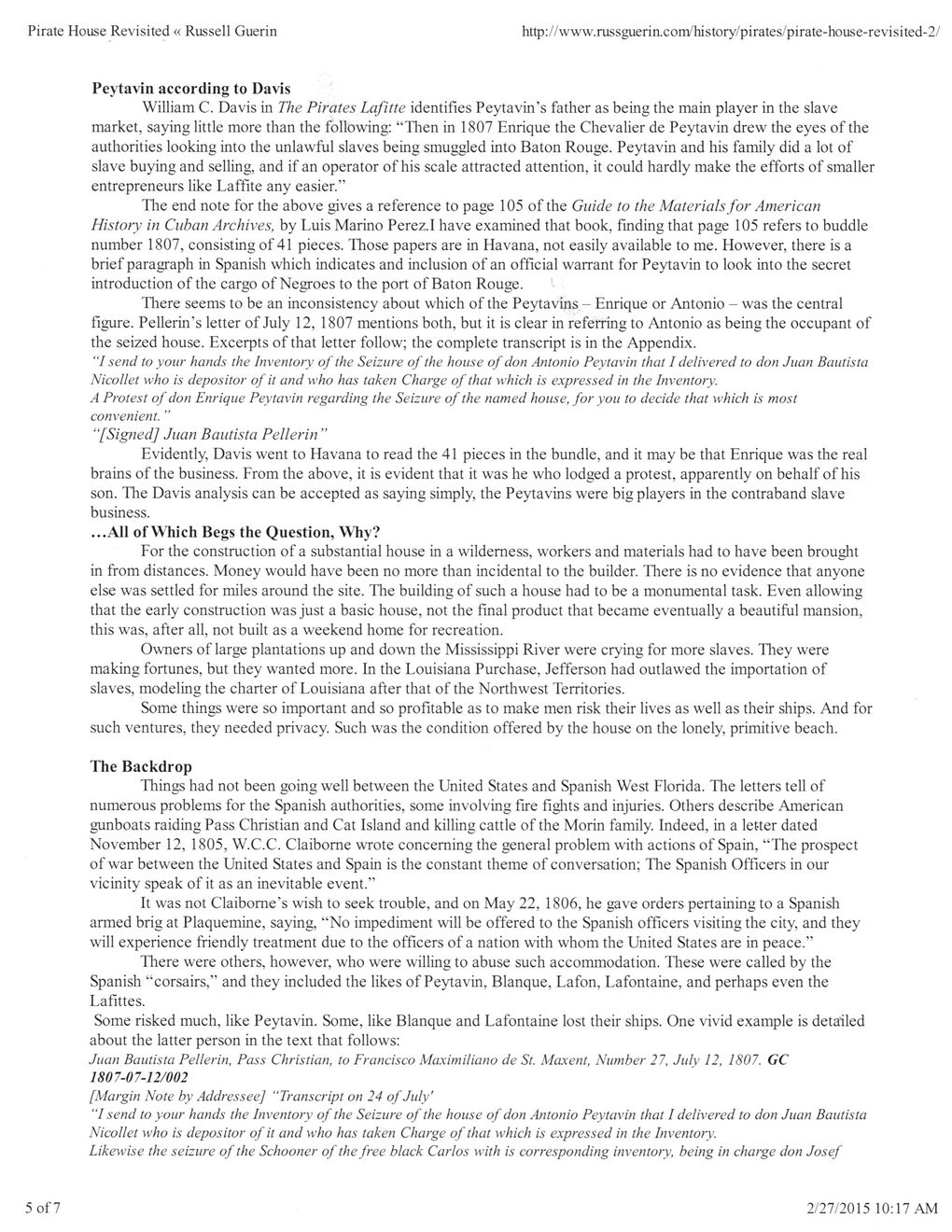This text was obtained via automated optical character recognition.
It has not been edited and may therefore contain several errors.
Pirate House Revisited « Russell Guerin http://www.russguerin.com/history/pirates/pirate-house-revisited-2/ Peytavin according to Davis William C. Davis in The Pirates Lafitte identifies Peytavin’s father as being the main player in the slave market, saying little more than the following: “Then in 1807 Enrique the Chevalier de Peytavin drew the eyes of the authorities looking into the unlawful slaves being smuggled into Baton Rouge. Peytavin and his family did a lot of slave buying and selling, and if an operator of his scale attracted attention, it could hardly make the efforts of smaller entrepreneurs like Laffite any easier.” The end note for the above gives a reference to page 105 of the Guide to the Materials for American History in Cuban Archives, by Luis Marino Perez.I have examined that book, finding that page 105 refers to buddle number 1807, consisting of 41 pieces. Those papers are in Havana, not easily available to me. However, there is a brief paragraph in Spanish which indicates and inclusion of an official warrant for Peytavin to look into the secret introduction of the cargo of Negroes to the port of Baton Rouge. There seems to be an inconsistency about which of the Peytavins — Enrique or Antonio — was the central figure. Pellerin’s letter of July 12, 1807 mentions both, but it is clear in referring to Antonio as being the occupant of the seized house. Excerpts of that letter follow; the complete transcript is in the Appendix. “I send to your hands the Inventory of the Seizure of the house of don Antonio Peytavin that I delivered to don Juan Bautista Nicollet who is depositor of it and who has taken Charge of that which is expressed in the Inventory. A Protest of don Enrique Peytavin regarding the Seizure of the named house, for you to decide that which is most convenient. ” “[Signed] Juan Bautista Pellerin ” Evidently, Davis went to Havana to read the 41 pieces in the bundle, and it may be that Enrique was the real brains of the business. From the above, it is evident that it was he who lodged a protest, apparently on behalf of his son. The Davis analysis can be accepted as saying simply, the Peytavins were big players in the contraband slave business. ...All ofWhich Begs the Question, Why? For the construction of a substantial house in a wilderness, workers and materials had to have been brought in from distances. Money would have been no more than incidental to the builder. There is no evidence that anyone else was settled for miles around the site. The building of such a house had to be a monumental task. Even allowing that the early construction was just a basic house, not the final product that became eventually a beautiful mansion, this was, after all, not built as a weekend home for recreation. Owners of large plantations up and down the Mississippi River were crying for more slaves. They were making fortunes, but they wanted more. In the Louisiana Purchase, Jefferson had outlawed the importation of slaves, modeling the charter of Louisiana after that of the Northwest Territories. Some things were so important and so profitable as to make men risk their lives as well as their ships. And for such ventures, they needed privacy. Such was the condition offered by the house on the lonely, primitive beach. The Backdrop Things had not been going well between the United States and Spanish West Florida. The letters tell of numerous problems for the Spanish authorities, some involving fire fights and injuries. Others describe American gunboats raiding Pass Christian and Cat Island and killing cattle of the Morin family. Indeed, in a letter dated November 12, 1805, W.C.C. Claiborne wrote concerning the general problem with actions of Spain, “The prospect of war between the United States and Spain is the constant theme of conversation; The Spanish Officers in our vicinity speak of it as an inevitable event.” It was not Claiborne’s wish to seek trouble, and on May 22, 1806, he gave orders pertaining to a Spanish armed brig at Plaquemine, saying, “No impediment will be offered to the Spanish officers visiting the city, and they will experience friendly treatment due to the officers of a nation with whom the United States are in peace.” There were others, however, who were willing to abuse such accommodation. These were called by the Spanish “corsairs,” and they included the likes of Peytavin, Blanque, Lafon, Lafontaine, and perhaps even the Lafittes. Some risked much, like Peytavin. Some, like Blanque and Lafontaine lost their ships. One vivid example is detailed about the latter person in the text that follows: Juan Bautista Pellerin, Pass Christian, to Francisco Maximiliano de St. Maxent, Number 27, July 12, 1807. GC 1807-07-12/002 [Margin Note by Addressee] “Transcript on 24 of July' “I send to your hands the Inventory of the Seizure of the house of don Antonio Peytavin that I delivered to don Juan Bautista Nicollet who is depositor of it and who has taken Charge of that which is expressed in the Inventory. Likewise the seizure of the Schooner of the free black Carlos with is corresponding inventory, being in charge don Josef 5 of 7 2/27/2015 10:17AM

Pirate House Document (018)